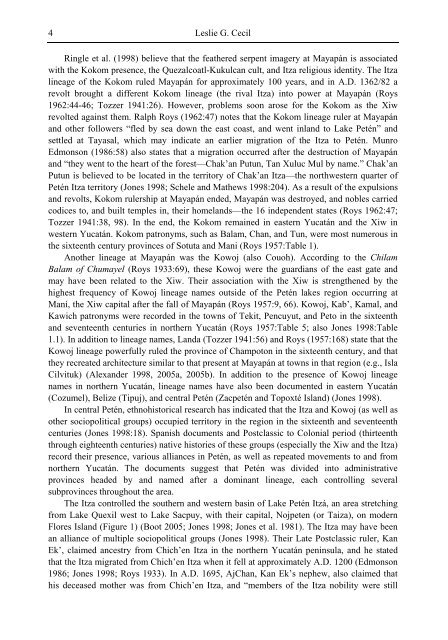Developments in Ceramic Materials Research
Developments in Ceramic Materials Research
Developments in Ceramic Materials Research
Create successful ePaper yourself
Turn your PDF publications into a flip-book with our unique Google optimized e-Paper software.
4<br />
Leslie G. Cecil<br />
R<strong>in</strong>gle et al. (1998) believe that the feathered serpent imagery at Mayapán is associated<br />
with the Kokom presence, the Quezalcoatl-Kukulcan cult, and Itza religious identity. The Itza<br />
l<strong>in</strong>eage of the Kokom ruled Mayapán for approximately 100 years, and <strong>in</strong> A.D. 1362/82 a<br />
revolt brought a different Kokom l<strong>in</strong>eage (the rival Itza) <strong>in</strong>to power at Mayapán (Roys<br />
1962:44-46; Tozzer 1941:26). However, problems soon arose for the Kokom as the Xiw<br />
revolted aga<strong>in</strong>st them. Ralph Roys (1962:47) notes that the Kokom l<strong>in</strong>eage ruler at Mayapán<br />
and other followers “fled by sea down the east coast, and went <strong>in</strong>land to Lake Petén” and<br />
settled at Tayasal, which may <strong>in</strong>dicate an earlier migration of the Itza to Petén. Munro<br />
Edmonson (1986:58) also states that a migration occurred after the destruction of Mayapán<br />
and “they went to the heart of the forest—Chak’an Putun, Tan Xuluc Mul by name.” Chak’an<br />
Putun is believed to be located <strong>in</strong> the territory of Chak’an Itza—the northwestern quarter of<br />
Petén Itza territory (Jones 1998; Schele and Mathews 1998:204). As a result of the expulsions<br />
and revolts, Kokom rulership at Mayapán ended, Mayapán was destroyed, and nobles carried<br />
codices to, and built temples <strong>in</strong>, their homelands—the 16 <strong>in</strong>dependent states (Roys 1962:47;<br />
Tozzer 1941:38, 98). In the end, the Kokom rema<strong>in</strong>ed <strong>in</strong> eastern Yucatán and the Xiw <strong>in</strong><br />
western Yucatán. Kokom patronyms, such as Balam, Chan, and Tun, were most numerous <strong>in</strong><br />
the sixteenth century prov<strong>in</strong>ces of Sotuta and Mani (Roys 1957:Table 1).<br />
Another l<strong>in</strong>eage at Mayapán was the Kowoj (also Couoh). Accord<strong>in</strong>g to the Chilam<br />
Balam of Chumayel (Roys 1933:69), these Kowoj were the guardians of the east gate and<br />
may have been related to the Xiw. Their association with the Xiw is strengthened by the<br />
highest frequency of Kowoj l<strong>in</strong>eage names outside of the Petén lakes region occurr<strong>in</strong>g at<br />
Maní, the Xiw capital after the fall of Mayapán (Roys 1957:9, 66). Kowoj, Kab’, Kamal, and<br />
Kawich patronyms were recorded <strong>in</strong> the towns of Tekit, Pencuyut, and Peto <strong>in</strong> the sixteenth<br />
and seventeenth centuries <strong>in</strong> northern Yucatán (Roys 1957:Table 5; also Jones 1998:Table<br />
1.1). In addition to l<strong>in</strong>eage names, Landa (Tozzer 1941:56) and Roys (1957:168) state that the<br />
Kowoj l<strong>in</strong>eage powerfully ruled the prov<strong>in</strong>ce of Champoton <strong>in</strong> the sixteenth century, and that<br />
they recreated architecture similar to that present at Mayapán at towns <strong>in</strong> that region (e.g., Isla<br />
Cilvituk) (Alexander 1998, 2005a, 2005b). In addition to the presence of Kowoj l<strong>in</strong>eage<br />
names <strong>in</strong> northern Yucatán, l<strong>in</strong>eage names have also been documented <strong>in</strong> eastern Yucatán<br />
(Cozumel), Belize (Tipuj), and central Petén (Zacpetén and Topoxté Island) (Jones 1998).<br />
In central Petén, ethnohistorical research has <strong>in</strong>dicated that the Itza and Kowoj (as well as<br />
other sociopolitical groups) occupied territory <strong>in</strong> the region <strong>in</strong> the sixteenth and seventeenth<br />
centuries (Jones 1998:18). Spanish documents and Postclassic to Colonial period (thirteenth<br />
through eighteenth centuries) native histories of these groups (especially the Xiw and the Itza)<br />
record their presence, various alliances <strong>in</strong> Petén, as well as repeated movements to and from<br />
northern Yucatán. The documents suggest that Petén was divided <strong>in</strong>to adm<strong>in</strong>istrative<br />
prov<strong>in</strong>ces headed by and named after a dom<strong>in</strong>ant l<strong>in</strong>eage, each controll<strong>in</strong>g several<br />
subprov<strong>in</strong>ces throughout the area.<br />
The Itza controlled the southern and western bas<strong>in</strong> of Lake Petén Itzá, an area stretch<strong>in</strong>g<br />
from Lake Quexil west to Lake Sacpuy, with their capital, Nojpeten (or Taiza), on modern<br />
Flores Island (Figure 1) (Boot 2005; Jones 1998; Jones et al. 1981). The Itza may have been<br />
an alliance of multiple sociopolitical groups (Jones 1998). Their Late Postclassic ruler, Kan<br />
Ek’, claimed ancestry from Chich’en Itza <strong>in</strong> the northern Yucatán pen<strong>in</strong>sula, and he stated<br />
that the Itza migrated from Chich’en Itza when it fell at approximately A.D. 1200 (Edmonson<br />
1986; Jones 1998; Roys 1933). In A.D. 1695, AjChan, Kan Ek’s nephew, also claimed that<br />
his deceased mother was from Chich’en Itza, and “members of the Itza nobility were still
















